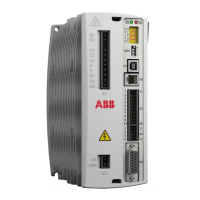Electrical installation: input / output 67
Special functions on inputs DIN1, DIN2
DIN1 and DIN2 can be configured to perform special functions.
Step (pulse) and direction inputs
DIN1 and DIN2 can be configured using the statement ENCODERMODE(1)=4 to
become step and direction inputs:
• DIN1 is used as the step input. The step frequency controls the speed of the
motor.
• DIN2 is used as the direction input. The state of the direction input controls the
direction of motion. An active input will result in forward motion. An inactive input
will result in motion in the opposite direction.
Encoder input
DIN1 and DIN2 can be configured using the statement ENCODERMODE(1)=0 to form
an additional encoder input. The two channels are read as a quadrature (CHA, CHB)
encoder input.
In Mint, the encoder input formed by digital inputs DIN1 and DIN2 is encoder 1. The
primary motor feedback encoder source on connector X8 is encoder 0, and the extra
incremental encoder on connector X8 is encoder 2; see pages 80 and 86.
Fast latch input
DIN1 or DIN2 can be configured using the LATCHTRIGGERCHANNEL keyword to
become a fast latch input. This allows the position of the axis to be captured in real-
time and read using the Mint keyword LATCHVALUE. The input can be configured
using the LATCHTRIGGEREDGE keyword to be triggered either on a rising or falling
edge. Further control of position capture is provided by various other keywords
beginning with LATCH.... See the Mint help file for details.
The maximum latency to read the fast position depends on the feedback device. For
an incremental encoder, the latency is approximately 150 - 300 ns. For other
feedback devices latency can be up to 62.5 μs, resulting from the 16 kHz sampling
frequency used for these types of feedback device. The fast interrupt will be latched
on a pulse width of about 30 μs, although a width of 100 μs is recommended to
ensure capture. The captured value is latched in software to prevent subsequent
inputs causing the captured value to be overwritten.
NOTE: The fast inputs are particularly sensitive to noise, so inputs must use shielded
twisted pair cable. Do not connect mechanical switches, relay contacts or other
sources liable to signal ‘bounce’ directly to the fast inputs. This could cause unwanted
multiple triggering.

